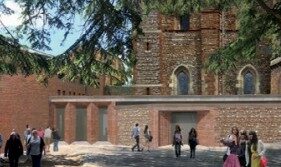
LOCATION: ST. ALBANS CATHEDRAL
MAIN CONTRACTOR: THOMAS SINDEN CONSTRUCTION
VENTILATION CONTRACTOR: CONSTANT AIR SYSTEMS LTD
CONSULTANT: MOTT MACDONALD,
SIMPSON AND BROWN ARCHITECTS,
MOMENTUM STRUCTURAL ENGINEERS
PRODUCTS: XBC UNITS
“Nuaire have been great at providing design advice to support us in overcoming this challenge whilst meeting changing energy regulations, as well as the architectural and conservation expectations.” Azu Hatch, Project Engineer at Mott MacDonald.
OVERVIEW //
St Albans Cathedral – Nuaire’s XBC supports ambitious conservation of Britain’s oldest shrine.
// THE PROJECT
Over 900 years old, St Albans Cathedral is the oldest site of continuous Christian worship in Britain, with most of its architecture dating back to Norman times. October 2017 saw the start of building work to create a new Welcome Centre, as well as renovation of the existing Chapter House, which provides specially adapted spaces designed for children and adult learning, and hosts the site’s library.
Commissioned in 2014, the design team were set a challenging yet exciting brief – to design a new visitor Welcome Centre, sympathetically connecting the main Cathedral building to its 1980’s Chapter House, and providing much-needed accommodation and modern facilities to support the varying needs of the Cathedral congregation, visitors and staff. The technical team comprised of Simpson and Brown Architects, Mott MacDonald for mechanical and electrical services engineering design, and Momentum Structural Engineers.
The Main Contractor was Thomas Sinden Construction, with ventilation installation work awarded to Constant Air Systems Ltd.
// CONSERVATION CHALLENGES
Prior to the refurbishment works, much of the Crypt and first floor Education spaces were naturally ventilated. However, the introduction of a new lift in the Chapter House has meant that the original 1980’s Crypt ventilation plant was left without means to deliver heat and ventilation to the largely windowless basement space, used for community groups.
Azu Hatch, project engineer at Mott MacDonald, explained: “The first floor Education Space will be used for community events, in line with the Cathedral’s new community and business plans. It was agreed that ducted ventilation and a comfort cooling system would be provided to meet standards for a modern space, with a best-fit sustainable solution.”
Being a listed and historical building meant the project presented various challenges for the design team to overcome, such as meeting regulations whilst ensuring the building remained relatively unchanged. She went on to comment: “Nuaire have been great at providing design advice to support us in overcoming this challenge whilst meeting changing energy regulations, as well as the architectural and conservation expectations.”
One major challenge for the project design team was to design in a heat recovery unit suitable of ventilating a space for 60 visitors, whilst ensuring no structural aspects of the listed building were changed. Nuaire XBC units were specified to meet regulations, whilst providing a solution to the space restrictions.
Nuaire Area Sales Engineer, Andrew Bott, worked closely with Mott MacDonald throughout design stages of the project. He commented: “One of the challenges here was to find a heat recovery unit that fitted under the newly constructed elevated floor void as space was a premium here. A major feature of the XBC that enabled this was depth – the XBC range of units is the shallowest
on the market relative to air volume.”
The XBC also has an integral condensate pump, which eliminates the need for a gravity drain, or condensate drain trap. This built-in condensate pump enables the units to be installed directly on top of the original 1980s sub-floor, avoiding permanent damage through drainage.”
XBC units are fully accessible from the side and require only 260mm for filter removal – this makes maintenance possible within the confined space. When the final timber floor is installed over the newly raised floor level incorporating the access hatches, the location of the unit means it will be almost invisible within the architecturally-sensitive space.
The first floor Education Space will be used for community events, in line with the Cathedral’s new community and business plans. It was agreed that ducted ventilation and a comfort cooling system would be provided to meet standards for a modern space, with a best-fit sustainable solution.
// SUMMARY
This transformation was supported by the Heritage Lottery Fund and one thousand donors, and, together with the city’s new Museum, will help to raise the profile of St Albans by transforming the way the Cathedral welcomes visitors.
Being a listed building meant the project presented various challenges for the design team to overcome, such as meeting regulations whilst ensuring the building remained relatively unchanged.
For more info, please visit:
www.nuaire.co.uk/XBC




